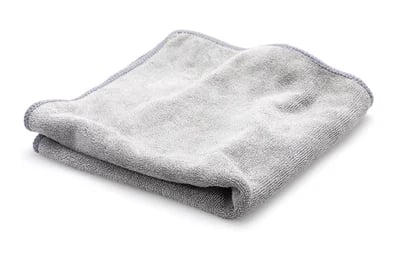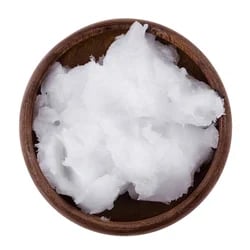.webp)
Oh no, your dog's got zits! Dog acne is real, folks, but the good news is that it's usually easy to treat and prevent! Clear your dog's skin with these 5 dog acne tips!
Acne in dogs is unpleasant to look at, but in most cases, very easy to treat. To help you get started, let’s talk about what’s causing your dog’s pubescent skin issue and find out how you can get rid of it for good.
Can Dogs Get Pimples?
Yep! Dogs can, and do get pimples. Dog acne is quite common, and there are many different factors that can contribute to your dog's lumpy muzzle. Dog pimples are often subtle at first and can go unnoticed, but once your pup is dealing with full-blown acne, it's hard to miss.
So, we know that dogs get pimples, but is it the same kind of canine acne that we suffer from? Much like acne in humans, dog acne can present in a few easily recognizable ways:
-
- Red Bumps
- Blackheads
- Pustules
- Swelling or redness around the muzzle
More severe cases of dog acne can lead to infection, which can present as more painful and oozing sores, especially for dogs that are scratching or rubbing the area to try to soothe their discomfort.
Because the early signs of dog acne can be missed, excessive scratching or face rubbing is the first sign that your dog may have some dog skin issues.
But Really, What is Dog Acne?
.webp?width=500&height=226&name=dog-acne-cross-section-illos%20(1).webp)
While the physical presentation can vary, dog and puppy acne is the result of a clog or build-up of oil, bacteria, and dead skin cells in a hair follicle. This build-up causes the pore to clog and create a sore at the surface of the hair follicle.
The oil, called sebum, is naturally produced by your dog’s skin to protect your dog's skin and coat. Inflammation in the follicle, bacteria, or hormonal changes can cause sebum to overproduce.
Often, when bacteria are trapped in the follicle, their body’s natural defence response is to release white blood cells to protect the infected area. This results in the nasty pus that can ooze from the pimples.
Yuck, right? Pus can be gross, but it has its purpose. In addition to acting to protect your dog from infection, it's a visible sign to you that your dog's body is in defensive mode.
What Causes Dog Acne?
We know what it is and what to look for, but why do some dogs have it and others don’t? Well, just like people, many factors can contribute to dog acne on the chin. While some causes of acne in dogs aren’t entirely understood, much like genetics and hormonal changes, we do know that some external factors are at play, too.
Let’s look at a few things that might be contributing to your dog’s pizza face, producing dog blackheads or a lumpy snout and lips:
Age
Acne is much more common in puppies than in older dogs. This indicates that hormones may very well be a factor. Most puppies who experience acne start to show symptoms between the ages of 5-8 months.
Canine acne can be very temporary or could last beyond 12-18 months in some cases. For many cases of adolescent dog acne, the conditions are mild and will go away on their own as they reach adulthood.
Poor Hygiene
The other very common contributor to acne in dogs is hygiene. Your dog’s personal hygiene is important, even with short coats. For breeds with extra wrinkles and skin folds around their face, hygiene tends to be compromised. Many dog breeds with short, bristly muzzle fur are at risk, too. Middle-aged dogs are especially prone to skin issues.
Some of the most common dog breeds to suffer from acne are ones that fall under both categories, like:
-
- Rottweilers
- Boxers
- English bulldogs
- Pugs
This is because those folds and crevices are a breeding ground for bacteria and dirt. In addition to collecting bacteria quickly, their short and coarse fur can easily irritate the skin in these areas.
Hygiene applies to more than just their bodies. Toys, beds, food, and bowls can all supply an unhealthy number of bacteria to your dog’s face. Your dog may not seem to mind his smelly, dirty toys, but his pores do.
Other Factors
While age and hygiene are the most common causes for your dog’s acne, there are other contributors to keep in mind, too:
-
- Allergies – both food and environmental allergies can contribute to inflammation and skin irritation.
- Mange, or other parasites – Many parasitic reactions can look quite like pimples.
- Fungal infections – fungus can create skin lesions and sores that can be mistaken for acne. Ringworm is a common zit-looking infection, as well as the Demodex mite.
5 Dog Acne Home Remedies
Acne in dogs can often be treated at home, but before you try to fix it yourself, it’s important to check in with your vet. Diseases, infections, and other illnesses need to be ruled out before you start dog acne treatment.
If you have been given the all-clear from your vet, then there are a few things you can do to get rid of your dog’s canine acne and keep it from coming back. How to treat dog acne?
1. Daily Face Wash
Keep your dog’s face clean. If you do have a wrinkly dog, then be diligent about cleaning the folds daily. Try to stick to warm water and a soft washcloth whenever possible. Frequent use of soaps and scented shampoos can dry out the skin, leading to more irritation.
If you're on the go, pet wipes come in handy. Opt for unscented or hypoallergenic ones whenever possible. Fragrances can further irritate your dog's skin condition.
2. Keep Him Dry

Dark, moist places are the perfect environment for bacteria to run rampant. Try to keep your dog’s muzzle dry to reduce bacteria populations.
Keep a dry towel handy to wipe his face after he drinks or eats. This is especially handy with extra drooly dogs.
3. Brush His Teeth
The bacteria in your dog’s mouth can easily transfer to his snout and muzzle area; again, this is especially true with drooly breeds. Keep his oral bacteria in check by brushing your dog’s teeth every day.
Dental care products like food or water additives can also help to control bacteria around the mouth.
4. Topical Treatments

Like our own acne, using a topical treatment can be useful in reducing symptoms and irritation. Talk to your vet about a topical gel or ointment that uses Benzoyl Peroxide. This ingredient is found in many human acne treatments.
We advise against buying a human product for your dog. Other ingredients, dosages, and formulas can be harmful to your pet, so talk to your vet about a pet-specific product.
If you are looking for some more natural topical remedies for canine acne and other chin acne, then maybe these will be a better fit for you:
-
- Coconut Oil
- Aloe Vera
- Diluted Apple Cider Vinegar
Apple cider vinegar is a great topical treatment because of its antibacterial properties, but should not be used on open skin, as it will sting.
5. Clean Toys and Bowls
Toys, bowls, and dog beds should be regularly cleaned. Look for beds that have removable, washable covers that can be cleaned or replaced when needed.
Most toys can be cleaned routinely to reduce bacteria and prolong the life of the toys. Check out How to Clean Dog Toys for tips on how to limit your dog’s exposure to nasty bacteria.
While bowls should, of course, be cleaned regularly too, that may not be enough to protect your pet. Plastic bowls and fountains retain way more bacteria than ones made of glass, ceramic, or metal.
Tiny cuts, scratches, and cracks are a great place for bacteria to hide and grow, so ditch the plastic bowls and switch to something more durable.
Keep an Eye On Your Dog’s Acne
Most cases of dog acne are easy to treat and go away when your dog becomes an adult, but if you do not see improvement, or if symptoms start to change, then it’s time for a vet visit.
Routine grooming and dental care offer ample opportunity to take note of your progress in treating your dog’s acne. Take pictures to help track success. If you do end up back at the vet, then at least you will have examples and evidence to help your vet determine the best course of action.
Dog Acne FAQs
What is dog acne?
Dog acne is a skin condition in dogs characterized by the formation of pimple-like bumps or pustules, often on the chin or muzzle. These bumps may be red, inflamed, or filled with pus.
What causes dog acne?
The exact cause of dog acne is not always clear, but it's often related to factors like hormonal changes, poor grooming habits, or contact with dirty surfaces (such as plastic bowls, which are porous and can harbour bacteria). While it may not always be preventable, maintaining good hygiene and cleanliness can help reduce the risk.
Is dog acne a serious medical condition?
Dog acne is usually a minor skin problem and is not considered a serious medical condition. However, it can become more severe or infected if left untreated, so it's essential to monitor and address it so the condition doesn't worsen.
How is dog acne treated?
Mild cases of dog acne can often be managed at home with gentle cleaning and topical treatments. Severe cases of dog acne may require antibiotics, topical creams, or other prescribed medications from a veterinarian.
Can I prevent my dog from developing acne?
While it may not always be preventable, you can reduce the risk of dog acne by keeping your dog's chin and muzzle clean, using non-irritating bowls, and maintaining proper grooming and hygiene practices.
When should I consult a veterinarian about my dog's acne?
If your dog's acne doesn't improve with at-home care, becomes infected, or if you notice signs of discomfort, such as excessive scratching or pain, consult a veterinarian. They can provide a proper diagnosis and recommend appropriate treatment options.
.png?width=200&height=66&name=logo%20(1).png)


.jpg)
